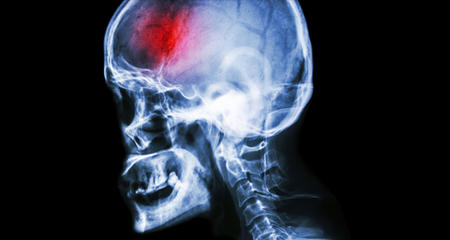
Arteriovenous malformations (AVMs) are relatively rare. Blood flow to the brain normally goes through three types of blood vessels.
- Muscular arteries deliver high-pressure flow to capillary beds in the brain.
- Capillary beds provide a large network to offload oxygen and other nutrients to the brain while reducing the high pressure.
- Veins receive the depleted blood at low pressures for transport back to the heart and lungs.
AVMs are an abnormal collection of blood vessels that lack a normal capillary bed. They result in the abnormally connected arteries transmitting blood at high pressures directly to the veins. The exact cause of AVM development is unclear. They may be present at birth or may also develop over a lifetime due to events including trauma and abnormal blood vessel development. Some very rare established genetic syndromes can increase the risk of hereditary AVMs.
Arteriovenous Malformation Symptoms and Diagnosis
Most people with AVMs have no symptoms. They may be discovered after a brain hemorrhage with potential symptoms that are similar to a stroke, including initial signs such as:
- Sudden onset of severe headache
- Weakness
- Numbness
- Difficulty speaking
- Vision changes
- Coma
If you experience any of these symptoms, call 911.
AVMs may also present with a seizure or an unrelenting pulse in your the ear. Even though you don't have symptoms, medical staff may find AVMs during imaging and testing for an unrelated medical condition.
Further imaging with a catheter-based cerebral angiogram is the gold standard to evaluate AVMs. With these images, we will determine the extent of blood vessel involvement and if the AVM has any high-risk features. The rate of bleeding and subsequent stroke from an AVM is variable and may be 2 to 4% every year.
AVM Treatment
An AVM is curable. The goal of AVM treatment is to eliminate the risk of future symptoms — including an AVM rupture (hemorrhage), while minimizing the risk of treatment. Your unique AVM characteristics influence both the decision to recommend treatment, as well as the treatments available. Surgical resection and radiosurgery are the primary AVM treatment methods.
- Surgical resection offers an excellent chance of cure in appropriately selected patients based on the patient and anatomical aspects of the AVM.
- Radiosurgery, typically Gamma Knife, uses targeted radiation therapy to shrink the AVM over the course of months or years.
- Endovascular embolization closes off the AVM blood vessels using a catheter guided by a cerebral angiogram. Embolization is mainly used before surgery or in conjunction with radiosurgery to reduce blood flow or eliminate high-risk AVM features.
Safe treatment of AVMs requires a careful multidisciplinary approach by doctors with expertise in medical monitoring, endovascular embolization, surgical resection, and radiosurgery. Our doctors specialize in treating these complex conditions and offer the latest treatment advances.
AVM Risks
It is important to choose the correct procedure for each patient. Any treatment carries risk, but patient outcomes are better at centers with a high volume of AVMs, such as Froedtert, where patient care is performed by a highly experienced and skilled multidisciplinary team. Our expertise in microsurgical, radiosurgical and endovascular techniques allows us to offer the most appropriate treatment for our patients.
Recognized as High Performing by U.S. News & World Report
Froedtert Hospital and Froedtert Menomonee Falls Hospital are recognized by U.S. News & World Report as high performing in stroke care.More to Explore





